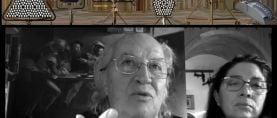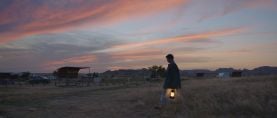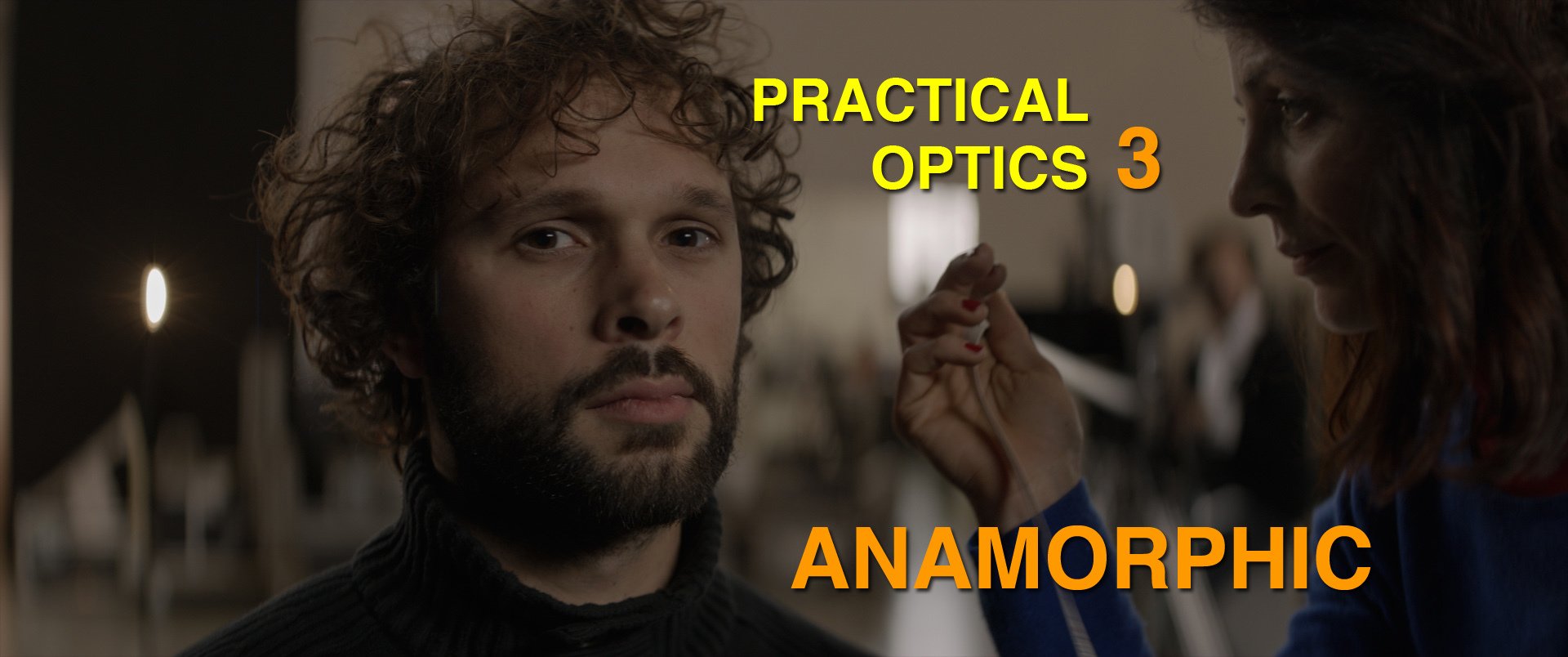
Practical Optics 3 - Introduction to Anamorphic
This post is part of an ongoing series of articles and posts on the theme of Practical Optics. My goal is to share simple and practical investigations of optical topics by shooting tests that can be easily reproduced by students.
This post is part of an ongoing series of articles and posts on the theme of Practical Optics. My goal is to share simple and practical investigations of optical topics by shooting tests that can be easily reproduced by students. In my first two posts -- and associated articles -- I addressed the changes in perspective created by different sensor sizes.
This post offers an introductory comparison between anamorphic and spherical lenses. The online post offers students illustrations with high quality in the native resolution, which is unavailable in the print articles. (Click on a test image to see or download its highest resolution version). The next post will feature videos of the tests discussed below.
I must stress that anamorphic cinematography is a rich and complex topic, and our tests here only address four very basic aspects: angle of view, depth of field, bokehs and flares. Note too that this post is not addressed at experienced filmmakers but rather at students of Optics, like me.
+++

1. Anamorphic, Briefly

Unlike ordinary spherical lenses, anamorphic lenses include an additional optical element that squeezes the image horizontally, without changing the image vertically. In traditional anamorphic the ratio of this horizontal squeeze is 2:1, so that the recorded image is half as wide as it would be with a spherical lens of the same focal length. Note that there are other squeeze ratios; for example, some Vantage Hawk V-Lite lenses offer a 1.3 squeeze, while Ultra Panavision 70 involves a 1.25 squeeze.
The traditional 2x anamorphic squeeze was introduced in Hollywood in the 1950s at a time when television was starting to threaten movies. The idea was to get a wider frame on to a piece of 4-perf film that had a squarish negative image area. The image was then un-squeezed at the theater by the film projector’s lens. Initially the anamorphic aspect ratio was 2.35:1, but evolved to 2.39:1, or 2.40 for short. The aspect ratio of the squeezed image is half that: 1.2:1, and fits snuggly into the 1.37:1 negative area of sound film.
When cinema made the transition to digital at the turn of this century, it was far from clear that anamorphic would survive as an important format, because the initial digital cameras had sensors targeting a 1.78:1 ratio, which was a poor fit for the 1.2:1 anamorphic squeezed image.
One of the important innovations of Arri’s Alexa camera was a “4 by 3” sensor mode, which was specifically designed to accommodate anamorphic, with an area similar to 35mm film. Thanks in great part to the Alexa, digital anamorphic is a vibrant standard today. Indeed some filmmakers are even using anamorphic lenses on 1.78:1 sensors, with a tighter angle of view than traditional anamorphic.
The ideas in this article are the result of my collaboration with two friends: Patrick Leplat, Director of Operations at Panavision Alga in Paris, and cinematographer Pierre-Hugues Galien, AFC.
Patrick was one of the early promoters of using anamorphic lenses with non-traditional sensor sizes and shapes, notably with Red cameras. Patrick kindly let us shoot in Panavision’s rental facility, where I used to work many years ago, and loaned us the equipment.
+++
2. Test Set-up and Crew
In our tests we shot with traditional 2x anamorphic lenses on an Arri Alexa XT, and compared them to spherical lenses framed for 2.40:1 on the same camera. We were fortunate to shoot with Panavision anamorphic lenses, including some of Patrick’s favorites: the Primo anamorphics, as well as an E135 longer lens, and two anamorphic zooms: the ALZ11 48-550mm Primo 11 to 1, and the recent AWZ2.3 37-85mm. For spherical lenses we used Primo primes. Our ArriRaw frames were timed, selected and transferred to TIFF using the Panavision Rush Management system developed at Panavision Alga Techno.
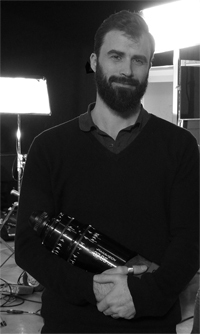
Pierre-Hugues Galien is an upcoming cinematographer whose credits include: Now or Never by Serge Frydman, Everything You Need by Cyril Gelblat, Close to the Sun by Yves Angelo and D Day by Reem Kherici. Pierre-Hugues masters both film and digital, and his work involves a special focus on emulating 35mm looks with digital images.
Pierre-Hugues gathered a talented crew for the shoot at Panavision Paris. The equipment was prepped by first camera assistant René-Pierre Rouaux and second Benoît Meignan. René-Pierre’s credits include Luc Besson films Lucy and Valerian, and Florida by Philippe Legay. Benoît also worked on Lucy, and other films like Wine Wars by Leon Lai. On the day of the shoot our on-camera talent included Emmanuelle Vivier (an emerging cinematographer after working as an electrician and camera assistant), camera assistant Adrien Guillaume, as well as Benoît.
We set up in Panavision Alga Techno’s grip area for the test. We placed a person in the foreground (first Emmanuelle, then Benoît) at about 4 feet from camera. Because we wanted to evaluate the out-of-focus image, we put Adrien in the background, operating a Millennium XL 35mm film camera, about 18 feet away from the Alexa. A third person (first Benoît, then Emmanuelle) then ran a focus tape between the background and foreground. You can evaluate the depth of field changes in more detail by viewing the video footage in my next blog post.
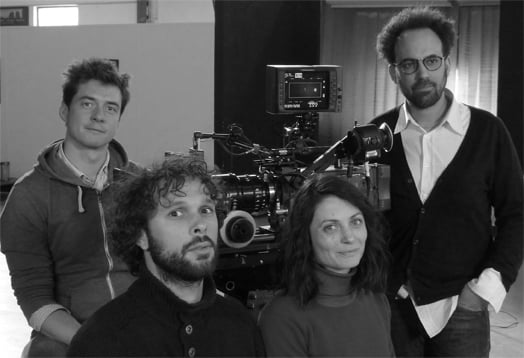
Pierre-Hugues’ lighting complemented the ambient daylight in Panavision Paris, with thanks to Yann Blitte and my friends at Panalux for providing the gear. Pierre-Hugues placed an SL1 as a key on the foreground person, and a Mini Switch at the camera, both from DMG Lumière; he added a K5600 800W Joker Bug to cover the entire scene. All three sources were outfitted with Chimeras to create soft daylight. We also added a bare light bulb on the right and a Panalens light on the XL camera to create luminous bokehs. We shot every lens wide open to create soft focus areas.
+++
3. TEST A - Spherical versus Anamorphic
In our first test we compared 3 sets of spherical (on the left, indicated by an orange S) and anamorphic lenses (on the right, indicated by a yellow A) at the same distance to our subjects.
Because of their twofold squeeze, anamorphic lenses have a horizontal angle of view that is twice as wide as a spherical lens of the same focal length at the same camera position.
This bears out in our first test. The spherical lenses have angles of view similar to anamorphic lenses with twice the focal length. For example S 75 (a 75mm spherical lens) has about the same horizontal angle of view as A 135 (a 135mm anamorphic lens). Note that we started our comparison with prime lenses, and didn’t have a 150mm anamorphic available.
One way to think about an anamorphic lens is to say that it combines the properties of 2 different spherical lenses:
-- A depth of field similar to that of a spherical lens with the same focal length
-- An angle of view similar to that of a spherical lens with half the focal length.
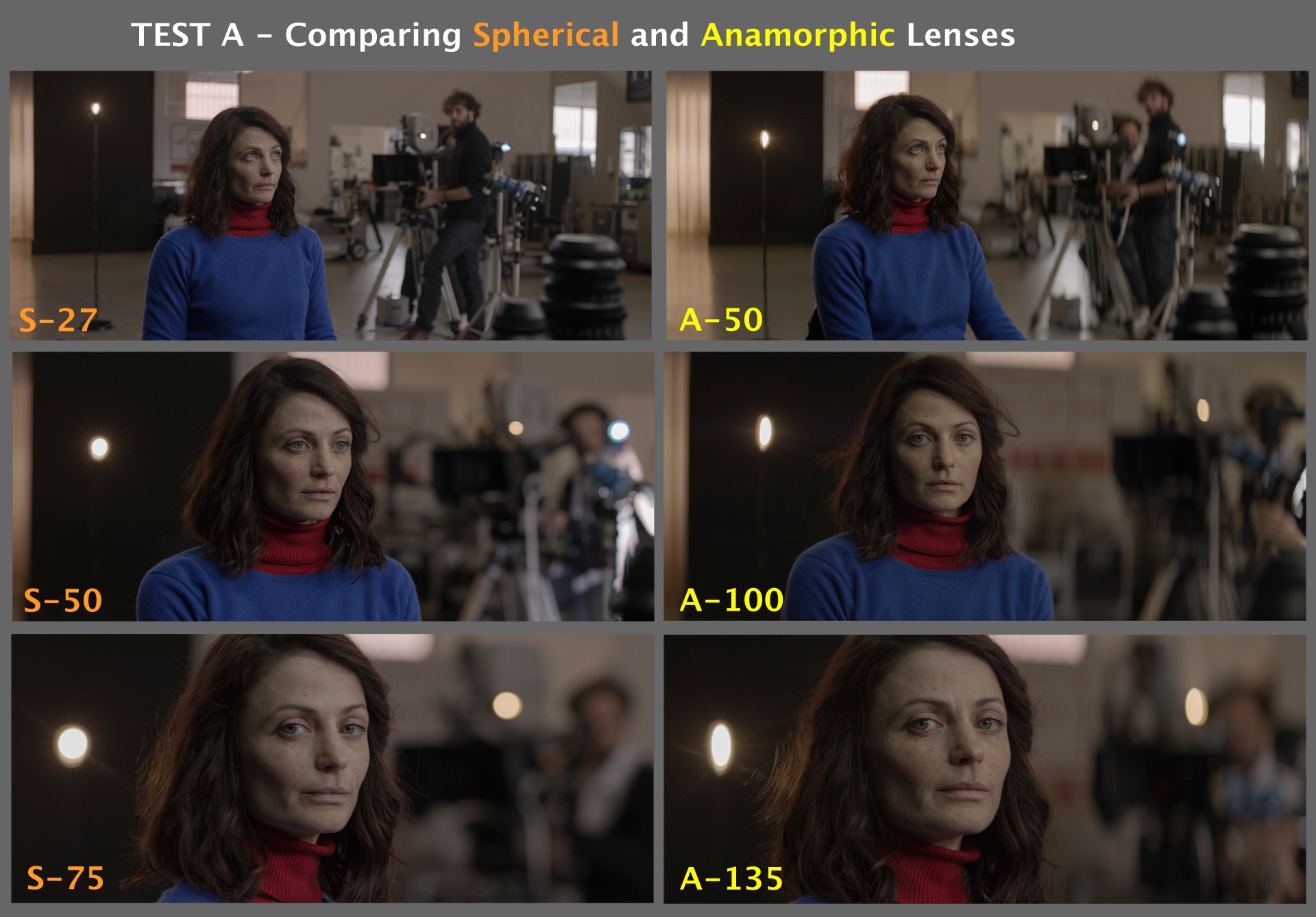
In this example, the anamorphic 50mm has an angle of view similar to the 27mm spherical; however the 50mm background is closer to the 50mm spherical in terms of depth of field; Adrien in the background is soft.
Put another way, with the same horizontal composition from the same camera position, anamorphic has less depth of field than spherical. This is sometimes stated in shorthand as “anamorphic has less depth of field than spherical”. The result is that a character in the same frame will appear more isolated from the environment in anamorphic than in spherical. In some circumstances this apparent isolation can also convey greater intimacy.
There is another aspect to the dual qualities of anamorphic lenses. As Pierre-Hugues pointed out to me, he feels it’s natural to shoot a close-up with a 50mm anamorphic, but less so with a 27mm spherical. In other words, the reduced depth of field of an anamorphic lens offers a unique combination of a close-up feeling with a wide shot frame.
+++
4. TEST A - Bokehs
Note that, while the depth of field is similar between 50-S and 50-A, the quality of the out of focus image is not. This is evident in the luminous bokehs of the light bulb on the left and lens light on the right. Bokeh is a Japanese word to denote what’s out of focus in an image. The soft-focus light bulb on the left is circular in the spherical images, but it becomes a tall oval in anamorphic.
The luminous bokehs are an obvious indication of what’s happening to the entire soft focus image. Everything that is out of focus is elongated vertically. The more things are out of focus, the more they are stretched vertically, from Benoît standing at the camera in A-50 to the Millennium camera in A-100, to Adrien’s face in A-135, which has become almost abstract.
This asymmetric elongation of soft focus objects in the frame is a key feature of anamorphic. The bokeh is an aesthetic quality that creates a feeling and mood that is difficult to describe objectively. Look at image A-135. To my eye, the vertical distortion of tall soft images creates a magical cinematic world that surrounds Emmanuelle, but for some filmmakers this quality may seem unnatural and artificial.
A related cinematic artifact is the anamorphic focus shift, which can change an object in frame from an oval to a circle, or the other way around. Some filmmakers find this transformation distracting. For others it can be very satisfying cinematic transition when accomplished by a talented 1st AC. The focus shift can be evaluated in the video footage in my next post.
+++
5. TEST B - Rear Versus Front Anamorphs
The second test we shot is a comparison of rear and front zoom anamorphs – the optical element in the lens that squeezes the image. With prime lenses, this attachment is usually added in front of the spherical portion of the lens. With zoom lenses, a front attachment sometimes implies too big a size and other optical constraints, so many manufacturers place the squeezing element at the back of an existing zoom lens, a modification that changes the bokeh.
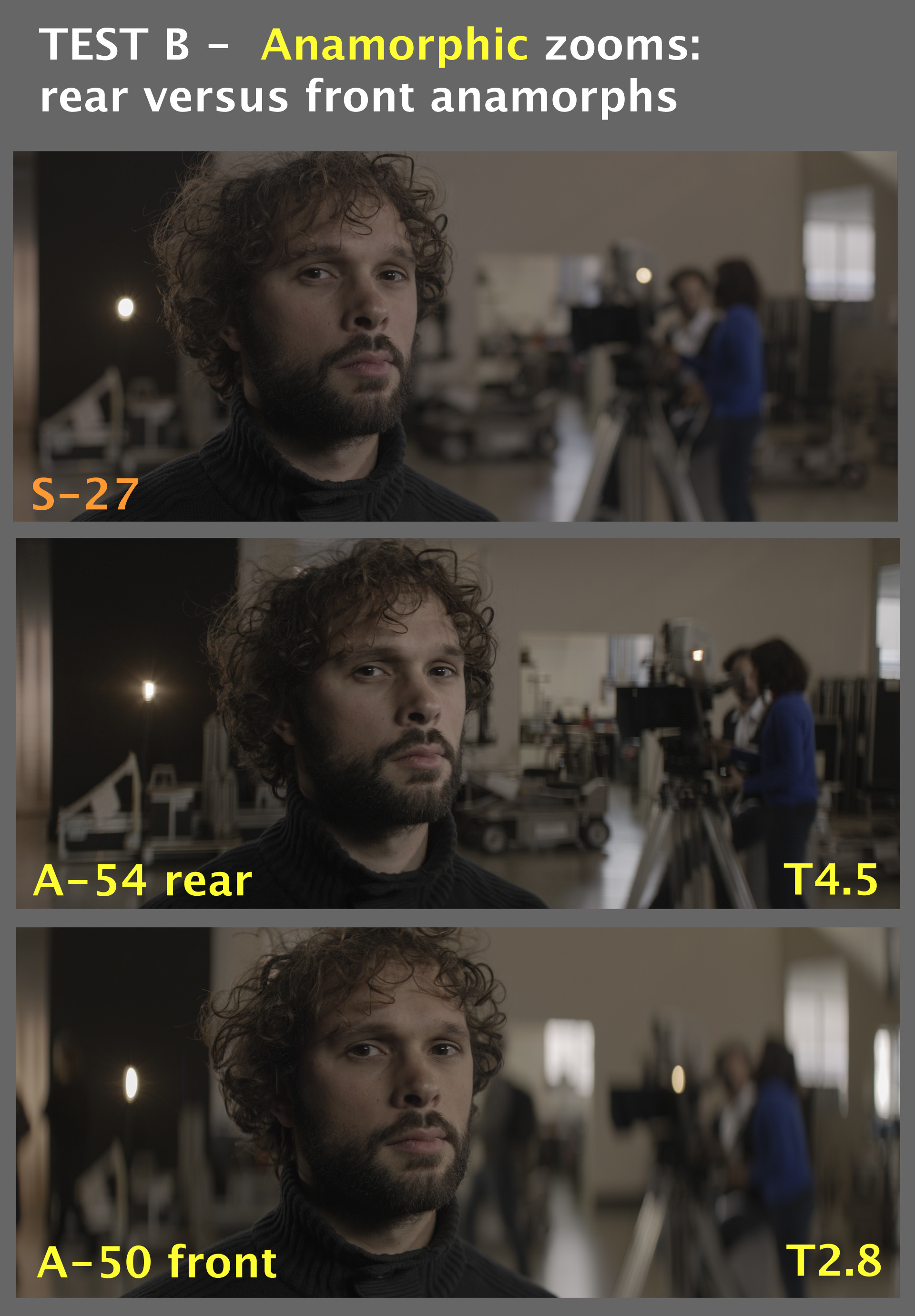
In our test we shot similar frames from the same position with a 27mm Primo and zooms with rear and front anamorphs. The bottom image created by a front anamorph on the AWZ2.3 is familiar, it has the same bokeh qualities that we saw in the first test.
The middle image with a rear anamorph ALZ11 is something else. The luminous bokehs of the light bulbs have a distinctive rectangular shape, and the out of focus areas are closer to spherical lenses than anamorphics. Note that the depth of field of the middle image is deeper than the 27mm prime lens. That is because we chose to shoot every lens wide open, to heighten bokehs. The ALZ11 is made by adding an anamorphic element to the back of a spherical SLZ11, which opens to T2.8. The addition of the rear element reduces the maximum aperture to T4.5. Thus, the increased depth of field is due to a smaller aperture.
+++
6. TEST C - Flares
Our last test explored flares. We placed a 200W Arri HMI PAR, and a Donner LED Spotlight and rotated each one to see what flares they created as they shone into the camera. Our results reflected the unpredictability of flares created by the complex interactions of light with the lens coating, elements and iris.
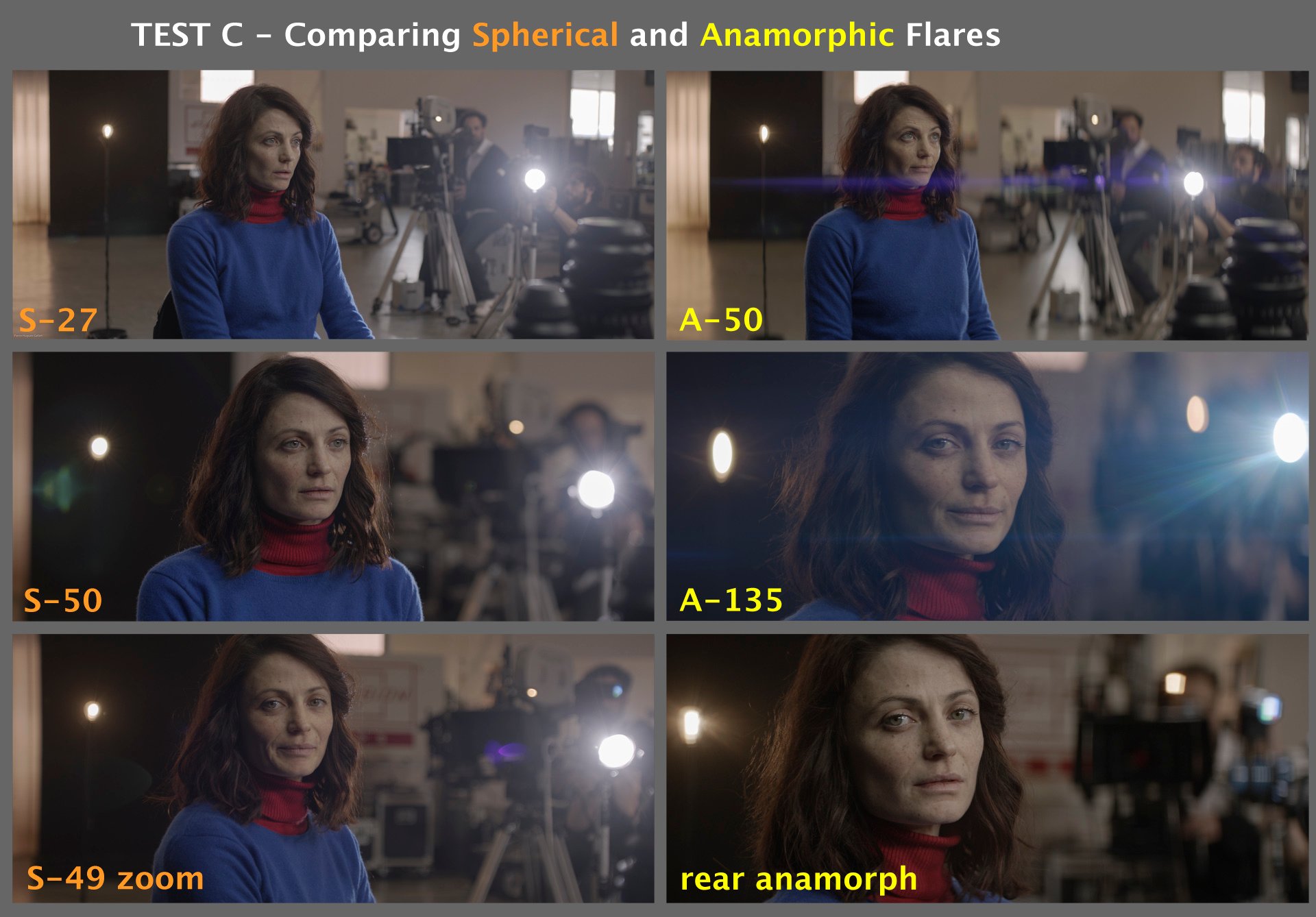
Anamorphic lenses are subject to flares partly because the glass in the front element offers a target for stray light beams on the set. The anamorphic squeeze also tends to give flares a horizontal shape. This is evident in image A-50, which exhibits a horizontal purplish “blue line” that is characteristic of the Primo anamorphic lenses.
The “blue line” is a good example of how the artifacts of anamorphic have entered into the cinematic vocabulary. This linear flare was introduced with the Primo Anamorphics in the 1980s and is associated with nighttime sequences in dozens of action movies. The blue line has now come to signify an action sequence, and some filmmakers seek to create them just to convey the genre. On the spherical lenses, we found that our lights tended to create an over-all glare, with occasional flare shapes. The anamorphic lenses tended to give us more lines. The final image is from a rear anamorph zoom, with its characteristic square bokehs.
+++
7. Anamorphic is not necessarily 2.40
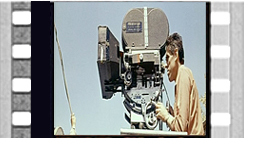
As noted above, 2x anamorphic was initially created to frame a wide-screen image with a 2.35:1 aspect ratio -- later refined to 2.40 – which was squeezed horizontally to fit snuggly in the area of the projected 35mm film print.
The advent of digital media however has eliminated the traditional space constraint of the film print, and the use of an un-squeezing projection lens. This means that anamorphic is no longer necessarily tied to the 2.40:1 aspect ratio.
Rodrigo Prieto, ASC, AMC, was one of the first cinematographers to put an anamorphic image in a 1.85:1 frame, in the multi-format Biutiful by Alejandro Iñarritu. Today, there are many examples of anamorphic photography in series and commercials framed in 1.78:1. In the era of digital cinema and elastic frames, anamorphic has become an optical system that is no longer tied to a specific frame shape.

+++
8. Conclusions
Our conclusions from this basic comparison of spherical and anamorphic lenses are simple:
-- From the same camera position, and with the same horizontal frame, anamorphic lenses can offer less depth of field than spherical lenses, enabling filmmakers to isolate a character from the environment.
-- Anamorphic lenses allow film-makers to film shots that combine a close-up isolation with a wide-shot composition
-- Anamorphic bokeh has a progressive vertical elongation that creates a distinctive and mysterious aesthetic, which can be seen as magical or unnatural, or both.
-- Zoom lenses with rear anamorphs do not have the same bokehs as lenses with front anamorphs, and the depth of field is closer to spherical lenses.
-- Anamorphic lenses tend to have more linear flares than spherical lenses.
-- Anamorphic is an optical process that is no longer tied to a specific aspect ratio
These tests mark only the beginning, we hope to continue to explore this complex cinema format in future installments.
+++
LINKS
PANAVISION
Panavision.com: About Anamorphic
uk.panavison.com: Primo Prime Lenses
K5600.com: Joker 800
dmglumiere.com: SL1 Switch
arri.com: Alexa Plus 4:3 for Anamorphic
YouTube: The cinemascope story
+++
thefilmbook: Bokeh Perfume -
Darius Khondji on anamorphic bokeh in Uncut Gems
THEFILMBOOK - PRACTICAL OPTICS
Practical Optics 1 - Testing Different Sensor Sizes
Practical Optics 2 - Notes on Lenses & Elastic Formats
Practical Optics 3 - Introduction to Anamorphic
Practical Optics 4 - Anamorphic Video Examples
+++
The two anamorphic graphics use a still frame of cinematographer Raoul Coutard from opening of Contempt by Jean-Luc Godard.
All other images, test photos & optics illustrations & video © Benjamin B 2017
All rights reserved.
+++

